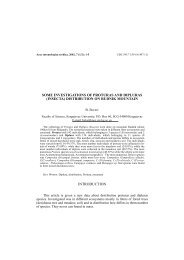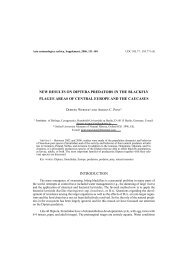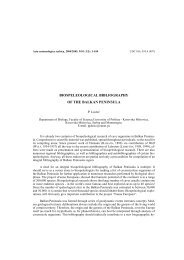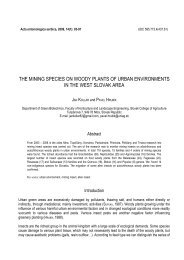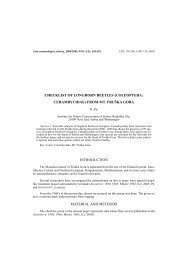Ćetković, A., Mokrousov, M., Plećaš, M., Bogusch, P., Antić, D ...
Ćetković, A., Mokrousov, M., Plećaš, M., Bogusch, P., Antić, D ...
Ćetković, A., Mokrousov, M., Plećaš, M., Bogusch, P., Antić, D ...
You also want an ePaper? Increase the reach of your titles
YUMPU automatically turns print PDFs into web optimized ePapers that Google loves.
Status of Asian Sceliphron spp. in Europe 101<br />
“the category V3 species – becoming rare due to human activities”, but also regarded its populations as<br />
“stable in the last 30 years, based on collections”. Also, he pointed out the fact that this is the single known<br />
population in European Russia, widely separated from its main range in Asia. Later on, the same author<br />
recognised the fact that S. deforme is actually an introduced species, and officially proposed its removal from<br />
the Red Book (MOKROUSOV, 2008, 2010; MOKROUSOV & ZRYANIN, 2010) as being “a synanthropic species<br />
with a tendency to spread, similar to its relative S. curvatum in western Europe”. However, MOKROUSOV’s<br />
reports on S. deforme in European Russia have not made their way to the wider audience involved in the<br />
studies of invasive alien insects: only his Red Book contribution (2003) was included in PULAWSKI’s<br />
comprehensive bibliography of the Sphecidae (2011; also in earlier versions since 2007); also, only two titles<br />
are recently cited by Russian authors (PROKOFIEV & SKOMOROKHOV, 2010; DANILOV, 2011).<br />
Unaware of MOKROUSOV’s first two reports (available by 2003), ĆETKOVIĆ et al. (2004) published their “first<br />
record of S. deforme in Europe”, based on the specimens collected in 2002 in Montenegro. This record was<br />
included in the subsequent wider treatment of the genus Sceliphron in Europe (SCHMID-EGGER, 2005), which<br />
had its principal emphasis on the first recorded Asian species – S. curvatum. Both ĆETKOVIĆ et al. (2004) and<br />
SCHMID-EGGER (2005) pointed out the necessity that all records of S. curvatum in Europe since 2002, and<br />
even most of the previous ones, be (re)checked for the possible presence of another (similar) alien species of<br />
the subgenus Hensenia. .Accordingly, SCHMID-EGGER (2005) thoroughly elaborated on the identity of all<br />
available European specimens and literature data (i.e. being or not being checked), on a country-to-country<br />
basis, also without any reference to the Russian records.<br />
In the next wider treatment of Sceliphron in Europe, BITSCH & BARBIER (2006) inadvertently misinterpreted<br />
some of SCHMID-EGGER’s (2005) elaborations regarding the identity issue of S. curvatum vs. S. deforme.<br />
Namely, in addition to the correctly cited Montenegrin record, they ascribed to SCHMID-EGGER (2005) some<br />
non-existent reports of S. deforme, from Italy (“un mâle pris à Bargellino, en Emilie-Romagne, le<br />
20.VIII.1998” – p. 229), Bulgaria (“les trois femelles prises à Hisarja, ... le 22.VI.1997, précédemment<br />
identifiées comme S. curvatum...” – p. 230) and Greece (“à Volos ..., qui rapporte ces observations, rattache<br />
les exemplaires à l’espèce S. deforme...” – p. 230); they summarised the known European distribution of<br />
S. deforme as: “Signalée de plusieurs pays d’Europe centrale, de Grèce et d’Italie du Nord, mais non connue<br />
de France” (p. 235). Later on, BITSCH (2010) omitted, without comments, all other countries except<br />
Montenegro and tentatively Greece (“pourrait se trouver également en Grèce”), correctly interpreting the only<br />
confirmed and one uncertain record from ĆETKOVIĆ et al. (2004).<br />
However, the erroneous treatment of the European range of S. deforme was partly retained and even<br />
extended in several subsequent publications (DAISIE, 2009; RASPLUS, 2010; RASPLUS et al., 2010; ROY et al.,<br />
2011), derived from the landmark EU/FP6 project “Delivering Alien Invasive Species Inventory for Europe”<br />
(HULME & ROY, 2010; etc). Most noteworthy are the detailed reviews of the status of invasive Hymenoptera in<br />
Europe (RASPLUS, 2010; RASPLUS et al., 2010 – both as chapters in the book “Arthropod invasions in<br />
Europe”). Following BITSCH & BARBIER (2006), RASPLUS (2010: p. 983) portrayed distribution of S. deforme as<br />
present in “Bulgaria, Greece, Italy and Montenegro”, while in the same publication, RASPLUS et al. (2010: p.<br />
755) listed Montenegro and France as invaded countries, they also gave the wrong year of introduction<br />
(1998), all based allegedly on ĆETKOVIĆ et al. (2004) as the only reference; in another place in the same<br />
paper, they correctly cited only “Balkans” (p. 678). The listing of France, derived from the unspecified data<br />
source incorporated earlier in the DAISIE (2008b) information system, probably appeared there as a<br />
technical error, since no other report of the species’ occurrence in that country exists anywhere. Finally,<br />
comprehensive CAB International database on invasive species (CABI, 2011b) also reproduced the<br />
erroneous country record for France, citing the same source (DAISIE, 2008b).



